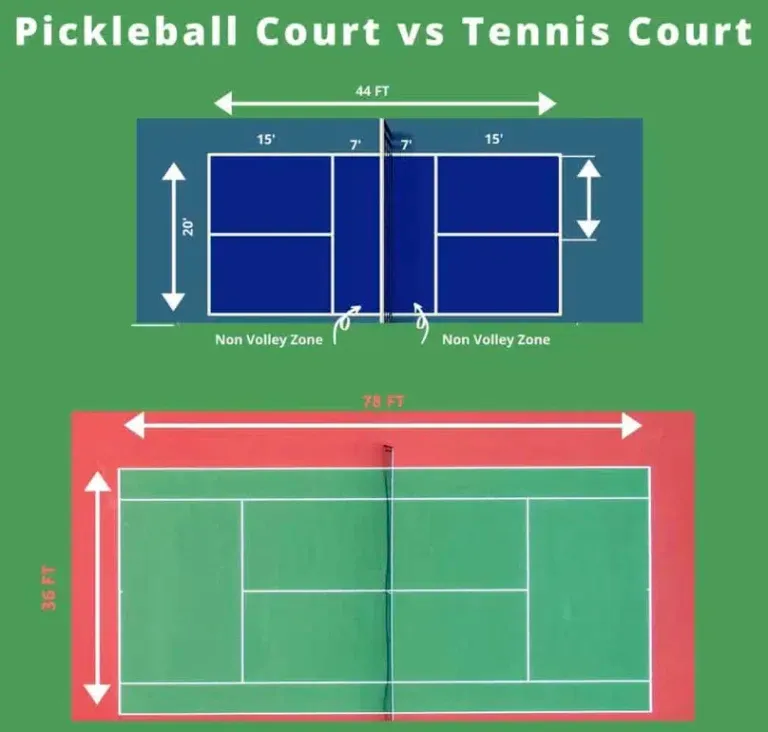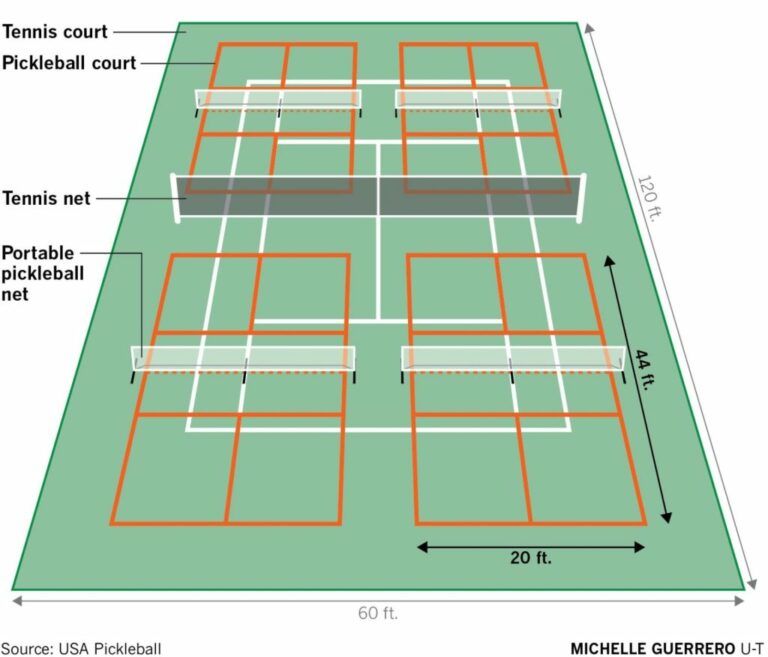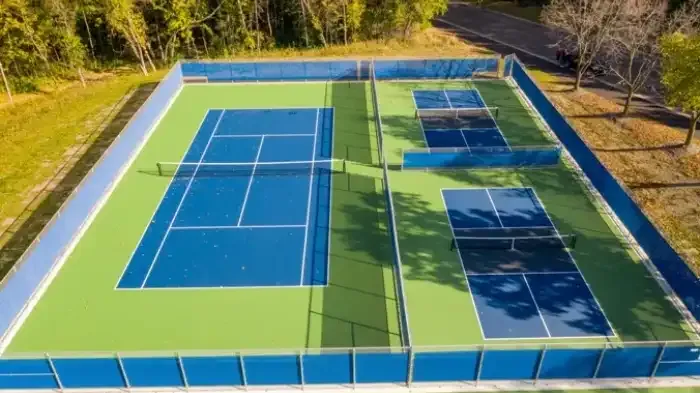Can you Play Pickleball on a Tennis Court? Understanding the basics
To fully appreciate the nuances of playing pickleball on a tennis court, it’s essential to understand the fundamental differences and similarities between the two sports. The dimensions of the courts, as well as the design of the nets and equipment, play a crucial role in how each game is played.
Comparing pickleball and tennis
- Court Size Differences:
- A standard pickleball court measures 20 feet wide by 44 feet long for doubles matches.
- In contrast, a tennis court used for doubles is significantly larger at 36 feet wide and 78 feet long, while singles matches use a court that is 27 feet wide.
- Net Height Variations:
- The net in pickleball is lower than in tennis, measuring 34 inches high in the center and 36 inches high at the sides, compared to a tennis net that consistently stands at 36 inches for both singles and doubles matches.
- Equipment Distinctions:
- Unlike the tennis racquets that are heavier and larger, pickleball uses smaller paddles made from composite materials, and the ball is a perforated plastic ball that is lightweight and designed for the unique style of play found in pickleball.

These differences set the stage for understanding how pickleball can comfortably cohabit with tennis courts, ultimately promoting a more inclusive recreational environment.
Why use a tennis court for pickleball?
The increasing popularity of pickleball has led to a pressing need for more playing courts, and many communities are finding innovative ways to satisfy this demand. Tennis courts are becoming a prime choice for this purpose.
Limited pickleball court access
- Dedicated Facilities: In many areas, dedicated pickleball courts are still scarce, which can lead to frustrations for local players eager to engage in the sport.
- Dual-Use Benefit: By adapting existing tennis courts for pickleball use, communities enhance their recreational offerings without the need for extensive renovations or additional investments in new facilities.
Ubiquity of tennis courts
- Tennis courts are widespread in neighborhoods, public parks, and recreational centers. This prevalence makes them an ideal solution for accommodating pickleball, allowing players of all ages and skill levels to engage with both sports.
- The adaptability of tennis courts to include markings and temporary structures for pickleball fosters not only accessibility but a communal spirit as more people participate.
Transforming a tennis court for pickleball
When it comes to playing pickleball on a tennis court, a few adaptations must be made. The transformation is not only simple but can be executed swiftly, allowing players to enjoy their favorite game with minimal fuss.

Marking pickleball lines on a tennis court
- Step-by-Step Guide:
- Utilize existing tennis service lines as a guideline to measure and mark the edges of the pickleball court.
- Establish baselines: A standard pickleball court requires sidings to be 10 feet from the centerline.
- Create a non-volley zone (the "kitchen") that measures 7 feet from the net to prevent players from smashing the ball close to the net.
- Recommended Materials: - Use cones, removable vinyl strips, or brightly colored tape to designate the boundaries without permanent modifications. This way, you can ensure it’s a safe environment while accommodating both sports.
- Safety Considerations: - It's essential to avoid creating tripping hazards and to always seek permission from the relevant authorities before marking the surface.
Adjusting the net height
- Lowering the Tennis Net: If a tennis net is adjustable, lowering the height to meet the regulation standard of 34 inches in the middle can facilitate a proper pickleball experience.
- Utilizing Portable Options: In instances where adjustment isn't feasible, portable pickleball nets are available, and they can be conveniently set up in conjunction with tennis facilities.
- Convert-a-Net Solutions: Products like Convert-a-Net allow for easy transitions from tennis to pickleball by providing an adaptable net system that meets the needed specifications.
Playing pickleball on a modified court
Transitioning to a modified tennis court requires players to adapt their gameplay effectively. Understanding how to navigate the larger playing area while maintaining strategic gameplay is crucial.

Adapting your game
- Shot Selection: With the larger area, players might prioritize lobs, drop shots, and deep drives. These strategies can be particularly advantageous when leveraging the extra space afforded by a tennis court.
- Footwork and Movement: Adaptability is key. Players will need to develop an awareness of covering more ground effectively, which will also enhance their endurance and agility.
- Doubles Communication: If playing in doubles, clear communication becomes even more vital to avoid stepping on each other’s toes and to ensure optimal court coverage.
Line calling and scoring
- Challenges with Line Calls: One of the nuanced challenges of playing in a dual-use format is maintaining equity when it comes to line calls, given the modified dimensions.
- Fair Play Recommendations: Players are encouraged to give the benefit of the doubt during line calls. A mantra of fun and camaraderie should prevail, with everyone prioritizing enjoyment over strict adherence to rules.
- Scoring Modifications: It may also be necessary to adapt the traditional scoring system to fit the context of a tennis court, potentially altering the two-serve rule to accommodate dual play.
Safety and etiquette
As with any sporting endeavor, maintaining safety on and off the court is paramount. With the blending of usages from tennis to pickleball, encouraging safe practices fosters a friendly atmosphere for everyone.
Staying safe on the court
- Awareness of Temporary Markers: Players must remain vigilant and avoid accidents that might arise from wooden or plastic markers placed on the courts.
- Collision Avoidance: With both sports being played side by side, awareness of tennis players and their balls from adjacent courts becomes essential.
- Proper Attire: Ensuring you wear the right footwear for the court surface reduces the chances of slips and falls, contributing to a safer playing environment.
Sharing the court respectfully
- Clear communication among tennis and pickleball players ensures a harmonious experience for all. Mixed usage can lead to scheduling overlaps; therefore, respectful interactions can facilitate a smoother playing atmosphere.
- Finally, after your games, ensure the court is free from equipment, personal belongings, and debris. Leaving it clean fosters goodwill amongst sports enthusiasts.
Finding tennis courts and alternatives
If you’re eager to start playing pickleball on a tennis court, knowing where to look can assist greatly in your search.
Locating tennis courts for pickleball
- Utilize online resources like Google Maps or dedicated sports apps like Place2Play to find local tennis courts that may accommodate pickleball.
- Investigate local parks and recreation centers for available courts, and contact those facilities directly to inquire more about their pickleball policies.
Exploring other options
- Dedicated Pickleball Courts: Seek out dedicated facilities for pickleball in your area. These courts often come with all the necessary adaptations already in place.
- Portable Courts: Consider temporary or portable setups for backyard play if you have space available. These options allow for flexibility and personal engagement in the pickleball community.
- Host Your Own: If conditions permit, creating a backyard pickleball court can provide a private space for practice and play.
Transitioning from tennis to pickleball
Many players come from a tennis background when trying out pickleball. Leveraging that expertise can significantly enhance the learning curve.
Leveraging your tennis expertise
- Transferable Skills: Skills such as net play, ball spinning techniques, and tactical awareness transfer smoothly from tennis to pickleball.
- Quick Reflexes: Tennis players often develop acute reflexes that come in handy during fast-paced exchanges in pickleball, making the transition smoother and more intuitive.
Adapting to pickleball
- Equipment Differences: Transitioning means using lighter paddles and a different type of ball, where the non-volley zone introduces a new tactical element.
- Understanding Rules: Players should familiarize themselves with pickleball’s distinct rules, including how scoring works, which differs from traditional tennis in several ways.
Benefits of practicing on a tennis court
Playing on a tennis court can provide unique advantages for those looking to sharpen their pickleball skills. Engaging with the game in this format can significantly improve performance.
Enhancing your pickleball game
- Shot Accuracy: Practicing on a larger court can refine shot placement and accuracy, equipping players with enhanced depth perception.
- Footwork and Court Coverage: The expanded area promotes agility and improves overall movement, ensuring players become more adept at coverage.
- Strategic Thinking: The necessity of adapting shots thanks to the size differences encourages stronger strategic decisions, benefiting overall gameplay.
Smoother transition to regulation play
Perhaps most importantly, getting comfortable with pickleball on a sizable court can facilitate a smoother transition when moving to regulation-sized play. This experience fosters confidence and prepares players for more structured environments.
In conclusion, yes, you can indeed play pickleball on a tennis court, transforming an ordinary space into a vibrant battleground of competitive spirit and community interaction. Whether you're a seasoned pro or new to the game, the flexibility of dual-use courts opens doors for everyone to enjoy both sports. Embracing this adaptability not only enriches local offerings but brings people together, encouraging a healthy lifestyle while celebrating the excitement of dynamic physical activity.










